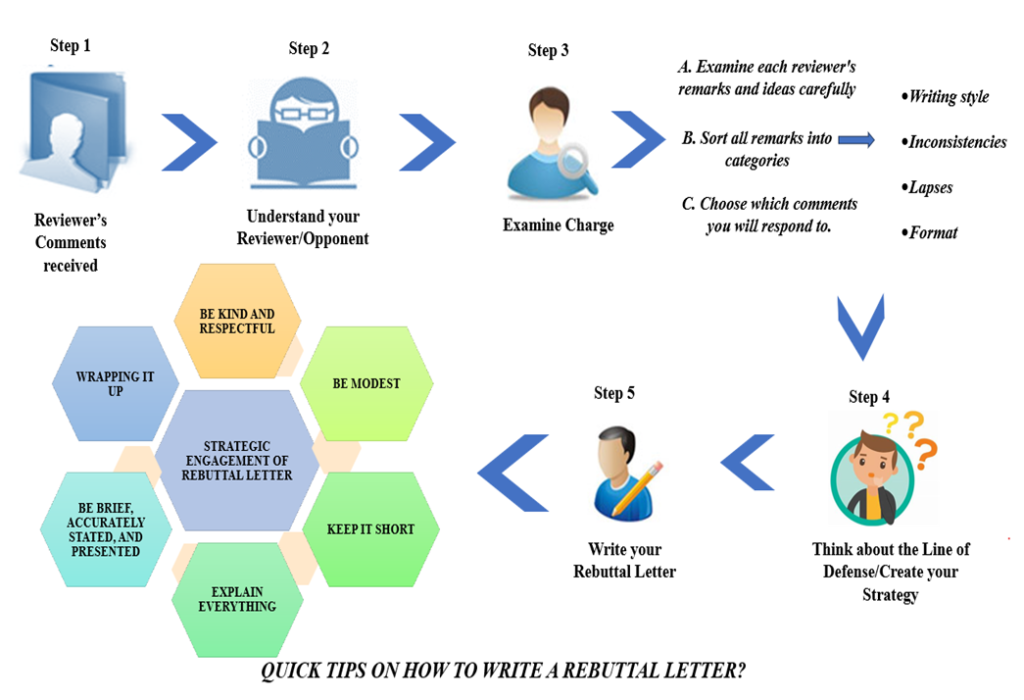Registered Address
Chandigarh-160035, India
Work Hours
Monday to Friday: 9AM - 6:30PM


Prepared by
Ms. Sandeep Kaur & Ms. Shelly Arora

Have you also faced that frustration when your manuscript, despite being drafted in a well-mannered way as per the journal requirements, received criticism from the reviewers? And now, are you in a situation to write a rebuttal letter to defend why the piece of literature was reviewed in that way?
Read our blog to get useful tips to combat this situation…
Let’s Understand First, What is a Rebuttal Letter?
When you submit a manuscript to a journal, the editors may react by explaining why the article was not immediately approved and what the author has to do to improve the work before resubmitting it. By writing a rebuttal letter, authors get a chance to directly respond to the reviewers’ concerns.
When Should You Draft a Rebuttal Letter?
In any sort of resubmission (revision, search for another journal), a well-written response letter is essential:
Here is the Stepwise Approach to Write a Rebuttal Letter

Let’s Elaborate.
Step 1: Understand Your Opponent
When applying to editors and reviewers, you should learn as much as you can about them. That way, you’ll be able to visualize those people as if you knew them personally, making it easier to communicate with them. Each editor and reviewer have extensive knowledge in their field. They are all extremely knowledgeable in their respective fields. This does not mean that you should not express your thoughts or agree with anything they say.
Step 2: Examine the Charge
1) Examine each reviewer’s remarks and ideas carefully
Some of the remarks may be offensive to you – which is fine. Keep in mind that no one intended to hurt you during the entire process of reading the evaluations. Reviewers have the same goal as you do. They want your content to be published and will provide you with a way to accomplish your goal. As a result, you should interpret their remarks as advice rather than insults.
2) Sort them all into categories.
If there are a lot of comments, categorize them so that you have a readily defined structure. Your rebuttal letter should be well organized. Here are a few categories that we suggest to sort the remarks you received:
3) Choose which comments you will respond to.
We advise you to rebut only the most important points. Also, keep in mind that you must remain objective. Even if they appeared to be good, you might consider changing certain sections. You must, however, maintain a healthy balance. Don’t agree with every single proposal. You should at least attempt to refute some of the claims. If not, editors might assume you did not put much effort into finishing the original work.
Step 3: Think about the Line of Defense
In writing a response letter, you entered into negotiations. As a result, developing a strategy is essential for success.
Follow these steps to create your strategy:
Step 4: Write Your Letter
Now, you can start writing your letter.

Few Tips and Suggestions
Editors and reviewers may evaluate your modifications differently as a result of the tone of your letter. Always start your response by expressing gratitude to the referees and editors for their time and insightful remarks on your paper. If the reviewers have misinterpreted something, bring it up gently and explain the confusion.
In the rebuttal letter, copy each reviewer’s critique and follow each point with a concise response. If the comments are lengthy paragraphs, divide them into distinct sections so you can respond to each one individually. Do not disregard the referees’ suggestions. Express gratitude for any compliments made in the evaluation. If any favorable remarks were made in the evaluation, mention them and thank the reviewer for their input.
Format your rebuttal letter in a formal, professional manner. Avoid using slang or informal language, and write clearly and concisely.
Hope this helps you in future. Good luck!